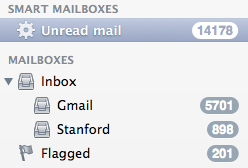Speak of coincidences – or a pileup of pressure: over the weekend one topic came up (as it does in a recurring way) with a group of classmates, yesterday there was this article (The Anxiety of the Unanswered E-Mail) making social media rounds and to top it off, Dave & Jason were having a ping-pong on usage of auto-responders on Twitter today (also see the Quora thread for context).
By “the topic” I mean the ever-worsening pain: humans’ inability to cope with their email load (and what the cultural implications of that are). As someone whose Mail client showed the following unread counts (aka “unprocessed”, really, in my personal methodology), I am obviously part of this global problem:
The shame of not answering in time (or ever) used to follow me for years, and the sorrow of not getting responses to many e-mail I send was there too, as a counter-punishment. I say “used to” and “was”, because it really does not any more.
Back in 2010 I scripted the following auto-responder message that for a while went out in return for every single incoming e-mail:
Hello,
I have adopted a new — if I may say, “zen” — approach to e-mail.
Imagine me as a buddhist monk sitting on the bank of a mighty river, watching the thousands of weekly messages flow by. Several times a day I reach into the river and fish out a dozen or a few of them. Others swim by unstopped as there is no way I could fetch them all. Yet, deep down inside I know that the messages that really need to find me, will. One day.
However, if you’d like to be more sure of my timely response to your message, please add me on Skype. My Skype name is “sten” and I’m increasingly online via our desktop and mobile clients (http://www.skype.com/intl/en/get-skype/).
Talk soon,
Sten
In a few weeks some of my frequent correspondents got too annoyed and I reconsidered the “auto” part: generating 1:1 matches for every incoming e-mail doesn’t help towards solving the overload for anyone, unfortunately. But 3 years later I still happily stand by the contents of this message for the most part, with a few comments and clarifications learned since:
- My diligence and discipline of getting back to people on Skype chat is still far better than e-mail, but there still is no universal conversation management tool for all. In business environment there was more convergence and control, but being back at school I need to juggle people and groups whose preference of communication channels can also vary between Facebook, LinkedIn, WhatsApp, Kakaotalk, GroupMe… Each context switch runs the risk of reducing response rates further.
- One thing for sure, e-mail is still part of this attention portfolio, but not it. The occasional excitement about some new UX paradigm with the promise to be more effective in handling e-mail comes and goes, but for example when the Mailbox app makes me swipe a few hundred (or 17,000?) times on a smaller screen as opposed to arrow-keying around on a larger one – the productivity benefit is too incremental to really win a notable share of my day or toolkit.
- Most importantly: it is pointless to be mad at people who don’t respond to you in expected time, if at all. 95% of the cases that piss you off would be just a fundamental attribution error in action (assigning blame not on situation but on character). If it burns, ask again. And better yet – think what you can do to make your first message as easily actionable as you can: short, crisp, with a clear action ask or response expectation, if any.
Or, as the author concludes on a very constructive note in that NYT piece:
So, here’s my idea. Those of us waiting for replies shouldn’t be so quick to leap to negative conclusions. It’s unlikely your best friend suddenly hates you. Or you’ve alienated a co-worker. Reach out again.
And to those who habitually don’t respond, try sending a quick e-mail just to say you can’t answer now. And if you really mean no, say no. Most of us can handle rejection. We just can’t handle not knowing.
